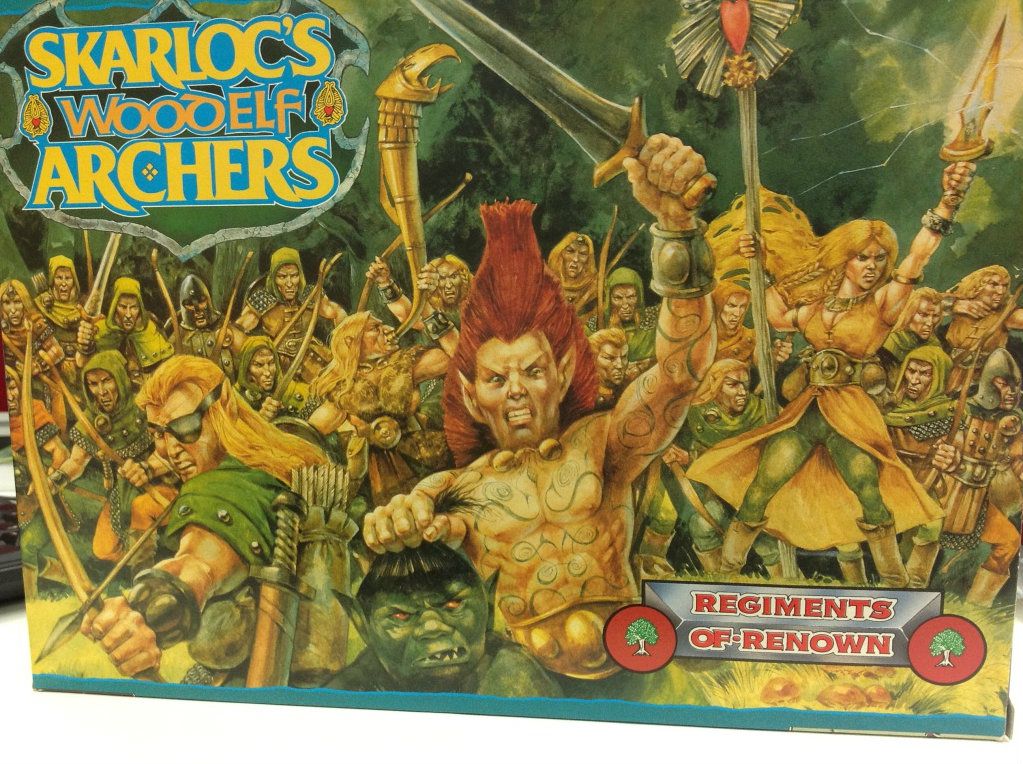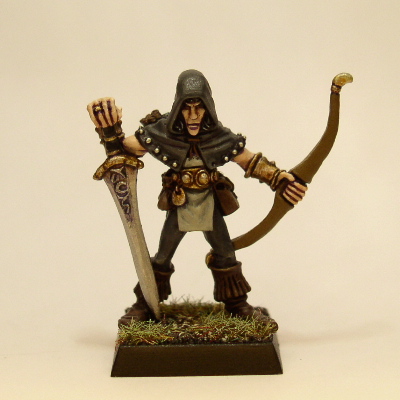We have Martin Walkyier - lead singer and songwriter of Sabbat - Wiccan influenced hymn to Pan "Horned is the Hunter". And in response to Walkyiers song "Horned is the Hunter", John Blanche graces the cover of Sabbat's first album with an androgynous sci-fi mutant in a position of meditation or spell-casting, or reading a book, or something.
The Horned God is (loosely) a male sexual deity which appears in the neopagan religion of Wicca, also associated with hunting, based on Pan, the English folklore figure Herne the Hunter and, controversially, the medieval concept of The Devil.
 |
| John Blanche "History of a Time To Come" 1988 Incidentally the image later turns up in Warhammer Fantasy Battle 3rd Edition. |
Horned is The Hunter
Then we have a remarkably similar image, the horns, the hair, the being seated, the ambiguous gender. This time it's the Chaos God Slaanesh, born from the death-screams of billions of Space-Elves. Blanches black and white Slaanesh is more hermaphroditic than the androgynous Sabbat figure, it's also nice to see the Dark Elf references with the chainmail armour.
Alone he sits -
a vanquished Lord upon an oaken throne,
presiding o'er this conflict
that chills him to the bone,
for each tarnished blade that festers
is a thorn thrust in his side,
and His pain alone bears witness
to the folly of mankind.
What hope for a king with no kingdom to rule?
now his children desert him -
regard him a fool,
and are bonded to progress -
the plough and the scythe -
that lay waste and leave barren
what beauty survives
though legends of power and glory suffice -
for these 'latter-day-heroes'
who live out their lives,
chained by conformity shackled by greed -
and told to belive they don't want to be freed.
The enemy within us -
is well armed to spoil and rape,
and this mighty heart grows weaker with
each liberty they take,
so come ye from the shadows
do not tremble 'neath your beds,
at the mention of his name -
hold high your weary heads.
For in each delve and greenwood,
far wiser creatures play,
and in their veins and sinews,
live the Gods of yesterday.
Both wicked and lustful
this God's horny might,
He plays hide and seek
with the shadows of the night,
enthroned in high mountains -
nobility crowned with the wisdom of ages -
the forest his gown,
so nimble the fingers that pipe out the tune,
simple and pure is the song of the moon -
that echoes each evening the ritual performed,
a lament for a God to a Devil transformed.
Are there men among us
prepared to face the fight
who'll stand by their convictions
'gainst overwhelming might,
so do not hide like cowards
and await the bitter end,
come take your courage in both hands
and join with me my friend.
For in each delve and greenwood,
far wiser creatures play,
and in their veins and sinews,
live the Gods of yesterday.
A God of many faces
yet none of them are known
existing in all places at all times -
His glory shown in the majesty of nature,
let the Hymn to Pan be sung
for the myth is but a History Of A Time To Come.
His name is eternal - His power unknown,
the ruler paternal - He watches alone,
as great cities tumble and empires fall,
amidst this confusion the Hunter stands tall.
John Blanche's Slaanesh from Realm of Chaos: Slaves to Darkness (p. 14) 1988
Then we have a remarkably similar image, the horns, the hair, the being seated, the ambiguous gender. This time it's the Chaos God Slaanesh, born from the death-screams of billions of Space-Elves. Blanches black and white Slaanesh is more hermaphroditic than the androgynous Sabbat figure, it's also nice to see the Dark Elf references with the chainmail armour.
The later fluff for the elves (WFB4+), introduces the horned god Kurnous (clearly referencing the Celtic figure identified as Cernunnos, who some claim influenced Herne the Hunter and is part of the syncretic wiccan concept) and his avatar Lord Orion, king of the Elves who thematically extends the relationship between the elves and a Horned God to before the Fall of the Eldar (although this does depend on reading a certain macrocosm-microcosm relationship of the Warhammer 40k and Fantasy universes) - could mean that Kurnous was intended as an aspect of Slannesh, or just that the whole thing is coming out of the same melting pot of influences.
Re-reading Walkyiers lyrics, certain lines do lend themselves to the character of Slaanesh:
Both wicked and lustful
this God's horny might
Although any direct influence would be pure speculation. It is clear that looking at the two images, Blanche was either re-using the same visual motifs, or perhaps drawing some form of comparison between the neo-pagan Horned God and the Chaos deity.
Scarloc, the leader of the Wood Elf Archers, is of course, named after a character from Robin Hood folklore, Will Scarlock (or Scarlett) and the band of green-clad forest dwelling bowmen clearly references the popular image of Robin Hood. Of course, based in Nottingham, the legends of Robin Hood would have been difficult for the denizens of GW to escape from.
Re-reading Walkyiers lyrics, certain lines do lend themselves to the character of Slaanesh:
Both wicked and lustful
this God's horny might
Although any direct influence would be pure speculation. It is clear that looking at the two images, Blanche was either re-using the same visual motifs, or perhaps drawing some form of comparison between the neo-pagan Horned God and the Chaos deity.
 |
| Scarloc's Wod Elf Archers | 1987 |
Scarloc, the leader of the Wood Elf Archers, is of course, named after a character from Robin Hood folklore, Will Scarlock (or Scarlett) and the band of green-clad forest dwelling bowmen clearly references the popular image of Robin Hood. Of course, based in Nottingham, the legends of Robin Hood would have been difficult for the denizens of GW to escape from.
But more specifically, the leader of these merry elves, Skarloc is given a hood, a rune-sword and is titled "The Hooded One"...
 |
| Skarloc 'The Hooded One" |
 | |
Michael Praed as Robin Hood Judi Trott as Lady Marion Robin of Sherwood (1984) |
In the 1984 TV Series Robin of Sherwood, Michael Praed plays Robin of Loxley, given the title "The Hooded Man" and like Scarloc goes around in a hood quite a bit, as you'd expect. However, Carpenter adds a neopagan twist to his retelling of the tale, and Robin is also "The Son of Herne" - a mystic shaman / avatar of the Horned God, an innovation unlike the Moorish Hashashin Nazir, that hasn't become widely adopted . This decidedly mystical bent gives much of the flavour, but rather than a strictly Anglo Saxon paganism with Woden, Thunor and Tiw, that would follow from the 'Saxon rebels and Norman oppressor' background of the story, Carpenter created a somewhat romanticised Wiccan basis for his pagan insurgents.
Back to Scarlocs, according to the description on the box-back Kia Stormwitch (the standard bearer) carries the ashes of an 'elf hero' called Kern - son of a goddess, which again seems to be a reference to Herne / Kernunos aspects of the Wiccan Horned God (who is somewhat perversely both the son and the lover of The Goddess) - the Kerne -> Herne consonant shift thought by some folklorists to be evidence for the figure of Herne as a 'survival' of a Celtic deity. In the TV series Robin has the magical rune-sword named Albion (one of a set, forged by Germanic folk hero Wayland the Smith) which may not be used to slay him - whilst similarly Scarloc has a magical rune-sword with runes of swiftness, armour and protection (rather than say, a Minor Death rune of goblin slaying or other offensive capabilities) .
So it follows, if the wood elves are based on Robin of Sherwood, so too might their deity and spiritual leader be, hence the development of Orion/Kurnous/Slannesh as gods of the Elves - all depicted with antlers, and 'lusty'. Robin of Sherwood was hugely successful TV series at the time, and even spawned a couple of Fighting Fantasy style gamebooks by Graham Staplehurst (who also wrote the Robin Hood supplement for Iron Crown Enterprises in 1987, and a couple of articles in White Dwarf on the subject too if memory serves) and illustrated by Russ Nicholson.
 |
| The Hooded Man? Robin of Sherwood Gamebook Russ Nicholson |
Sabbats History of a Time To Come remains one of my all time favourite albums to this day, and Robin of Sherwood still a very entertaining and TV series I'm somewhere in the middle of series 3 of Robin of Sherwood - The Complete Series although Mrs Zhu seems to have lost interest after Praed was replaced by Connery, still the costumes and scenery are nice to watch. I'm still not regretting selling my citadel wood elves, honest.




I didn't know these illos were used as sleeve on records.
ReplyDeleteGood to know about this, and about the little piece of british culture when you write mentioning the old tv series or folklore.
Fascinating blog you have here Zhu, I am enjoying floating around reading old posts. I too was (still am) a great Robin of Sherwood fan and was very interested the way the late Richard Carpenter wove in a neopagan thread into the stories, along with quite blatant Wiccan phraseology and ritual. For what it's worth Ronald Hutton in his history of modern witchcract 'The Triumph of the Moon', cites RoS as a major part of the 80's resurgence of neo-paganism. Nice to see Conquest minis are bringing out a range of figures based on the series, although I always used the Lone Wolf figure for Robin.
ReplyDeletecheers
Mike
Another great post. I loved Robin of Sherwood both as a kid, and again about 10 years ago when I picked up a ropey VHS boxed set of all three series. Parts of it were filmed in a public park near where I grew up, so it was particularly popular in our area. The HErne the Hunter episodes were particularly memorable as a kid. Very interesting to consider it's potential/likely influence on GW designers of the time. Also massive big up to the Ronald Hutton reference above. A great read by a great academic.
ReplyDeleteDon't know why I didn't mention Hutton in the original post. The Triumph of the Moon heavily informed its writing, although I'd read it a long time before.
DeleteI'm going to say that I think the Kern (GW) / Cernunnos / Herne link strongly suggests someone at GW (possibly whoever wrote the back-panel fluff) was familiar with the original neopagan source material as well as its connection to RoS. It's interesting that after the furore in the US (mostly) regarding D&D and Satanism, that GW would quite openly reference neopaganism, which is so often conflated with it.
To disentangle some of the history, I can't recall any neopagan references in earlier depictions of the elves (or other races), not in Oreons Bowmen (loss of an eye may be an obscure reference to Odin, but it seems not to be a sacrifice or give him any power).